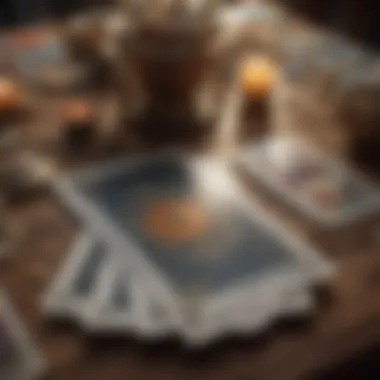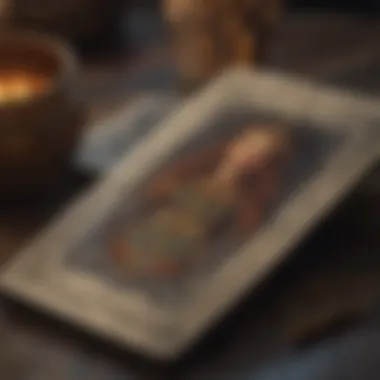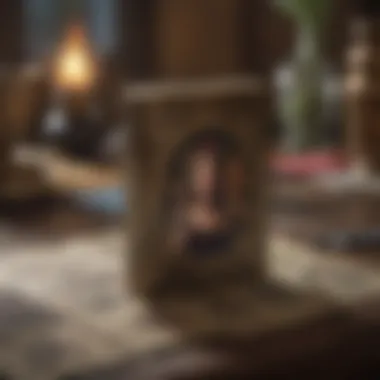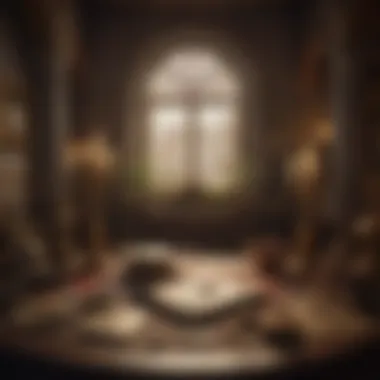Exploring Yes and No Tarot Spreads: A Comprehensive Guide


Intro
The practice of Tarot reading offers unique insights into decision-making processes. Among the various methodologies, Yes and No Tarot spreads present a clear approach to inquiries, providing direct answers amidst the often nebulous nature of life’s questions. By focusing on binary responses, practitioners can simplify complex situations and derive clarity, thereby enhancing their ability to make informed choices. This article will explore the meaning and framework of Yes and No Tarot spreads and their implications.
Through this guide, readers will understand the principles driving these Tarot spreads, delve into techniques for their implementation, and uncover nuances in interpreting their results. The emphasis will remain on practical application, catering to both novices and seasoned Tarot readers looking for effective ways to utilize these specific spreads.
Understanding Tarot Reading
The practice of Tarot reading is more than just an art; it is a complex system that intertwines history, psychology, and intuition. Understanding this practice is essential for anyone looking to explore Yes and No Tarot spreads effectively. It lays the foundation for how the cards can be interpreted and applied in decision-making scenarios.
Tarot readings offer insights that go beyond simple predictions. They help practitioners gain clarity on their situation, fostering personal growth and reflection. Understanding Tarot involves comprehending the symbols on the cards, the structure of the deck, and how these elements convey meaning.
Historical Background of Tarot
The origin of Tarot can be traced back to 15th century Europe, where it began as a card game. Throughout the centuries, it evolved into a tool for divination and self-reflection. The transition from a mere game to a mystical practice points to the human need for connection with the unknown. Tarot's journey reflects broader historical currents, including cultural exchanges and spiritual movements.
The structure of Tarot decks has remained consistent over time, anchored by the 78 card framework which includes the Major and Minor Arcana. Each card carries unique symbolism, and this symbolism is layered with historical and cultural significance. Understanding this rich backdrop is beneficial in grasping the significance of each reading.
Card Structure and its Importance
The layout of Tarot cards is crucial for interpreting their meanings. The deck is divided into the Major Arcana and the Minor Arcana, each serving different functions in readings.
Major Arcana
The Major Arcana consists of 22 cards, each representing significant life themes and spiritual lessons. Notable cards like The Fool and The World help convey profound messages during readings. Their contribution to understanding Yes and No Tarot spreads is significant as they often indicate major influences over the seeker’s life. Each card's strong archetypal energy can provide clarity on a question posed, establishing a more thoughtful approach to yes or no interpretations.
The unique feature of Major Arcana cards is their focus on broader, existential questions rather than mundane concerns. This characteristic makes them a popular choice for readers seeking deeper insights. The drawback, however, is that their complexity may overwhelm beginners trying to grasp their meanings quickly.
Minor Arcana
The Minor Arcana consists of 56 cards divided into four suits: Wands, Cups, Swords, and Pentacles. These cards reflect everyday situations and varied experiences, which makes them very relatable. Each suit deals with specific aspects of life, like emotions or actions, which can significantly influence the answers to yes or no questions.
The strength of the Minor Arcana lies in its capacity to dissect everyday dilemmas. However, because there are more cards, the risk of confusion or misinterpretation can increase, particularly for novices.
Suits and their Meanings
The Minor Arcana's four suits each carry distinct meanings:
- Wands symbolize action and creative energy,
- Cups represent emotions and relationships,
- Swords signify intellect and conflict,
- Pentacles denote material aspects and finances.
Understanding these meanings enhances the reader’s ability to provide nuanced yes or no insights based on various situational contexts.
Each suit’s unique features add depth to Tarot readings. However, focusing only on one could risk overlooking broader perspectives available through other suits.
Role of Intuition in Tarot
Intuition is a fundamental aspect of effective Tarot reading. It enables practitioners to interpret cards beyond their traditional meanings. While the imagery and symbolism of the cards provide a framework, intuitive insights can enhance understanding.
A reader’s intuitive response may vary based on their experiences and emotional state. Thus, honing this ability is important for accurate interpretations. Practitioners often find that their best readings come when they trust their instincts, allowing personal connections with the cards to guide their insights.
Yes and No Tarot Spreads Defined
Understanding Yes and No Tarot spreads is crucial for practitioners looking to gain clarity in decision-making. These spreads provide straightforward answers to specific questions. Unlike more complex spreads that reveal deeper insights, the Yes and No method focuses on binary outcomes, making it accessible for readers at all levels. This simplicity allows for quicker interpretations and can act as a powerful tool for both novice and seasoned tarot users.
Preamble to Yes and No Tarot Spreads
Yes and No Tarot spreads serve as a direct method of inquiry. They respond to questions that call for a straightforward affirmation or negation. These spreads simplify the intricate nature of tarot readings by reducing complexities into clear, actionable answers. This method can be particularly appealing for individuals who need decisive guidance in moments of uncertainty or confusion.


"Yes and No spreads can cut through the noise, providing direct answers where needed."
Purpose and Benefits of Using Yes and No Spreads
The primary purpose of employing Yes and No spreads is to deliver concise guidance. This is particularly beneficial in situations where clarity is needed quickly.
Some key benefits include:
- Speed: The direct nature of these spreads allows for rapid readings.
- Simplicity: They focus on specific queries, reducing the need for nuanced analysis.
- Accessibility: Their straightforward approach makes them suitable for readers of all experience levels.
- Focus: This method encourages individuals to be precise in their questioning, leading to clearer outcomes.
However, it is essential to understand that while Yes and No Tarot spreads provide binary answers, the nuances of life often exist in shades of gray. Practitioners should be aware of these complexities when drawing conclusions.
Types of Yes and No Tarot Spreads
In the realm of Tarot, Yes and No spreads serve to streamline complex inquiries into binary answers. Understanding the various types of Yes and No Tarot spreads caters to diverse questions and interpretations, enhancing decision-making processes for users. Each type presents unique qualities, which can suit different situations, preferences, and levels of expertise in readers. The effectiveness lies not just in knowing what is asked, but also in how the cards are arranged and interpreted in their context.
Three-Card Yes or No Spread
The Three-Card Yes or No spread is a commonly favored method among practitioners due to its simplicity and insightful nature. This spread typically consists of three cards drawn by the querent, where each card aids in creating a layered response. Often, the first card represents the response to the question—Yes, No, or Maybe. The second card offers additional context or factors to consider. The third card may reveal underlying influences or obstacles affecting the situation.
This format allows for not only direct answers but also the exploration of the nuances around the question asked. A reader can infer whether other elements play a vital role in the response, thus prompting a more profound reflection on the matter at hand.
One-Card Symbolism Approach
The One-Card Symbolism approach simplifies the process even further by focusing solely on a single card drawn from the deck. This method is optimal for quick guidance or for readers who may prefer a minimalist style. By concentrating on one card, practitioners can delve deeply into its symbolic meanings, allowing for various interpretations based on the querent’s question.
This technique operates on the understanding of the card's associations and the energy it carries. However, it is important to recognize that while a one-card reading can provide a clear answer, the depth of interpretation is limited compared to multi-card spreads. Thus, it serves best for straightforward questions or moments requiring immediate clarity.
Five-Card Clarification Spread
The Five-Card Clarification spread expands the traditional Yes or No readings by facilitating a richer narrative around the inquiry. In this arrangement, the first card indicates the primary answer, while the following cards assist in clarifying or expanding on that answer. Cards two through five can highlight influences, potential outcomes, or actions encouraged or discouraged by the chosen path.
This approach is helpful for more complicated inquiries or when the querent is on the fence about a choice. By examining multiple dimensions of the situation, the reader can illuminate factors that may not be initially apparent. Understanding how the cards relate to one another can lead to valuable insights for the querent.
"Every card drawn reveals new layers of truth that guide seekers towards wisdom in their decisions."
In summary, the various types of Yes and No Tarot spreads provide multiple pathways for exploring answers to pivotal questions. Each type serves a purpose, from quick assessments to deep explorations, and can align various readings with the querent's inquiry.
How to Perform Yes and No Tarot Spreads
Understanding how to perform Yes and No Tarot spreads is essential for anyone looking to utilize Tarot as a tool for decision-making. The clarity provided by these binary responses can guide practitioners through uncertain circumstances. Importantly, this process requires a thoughtful approach, ensuring the readings are both accurate and meaningful. Each step contributes to the overall effectiveness of the reading, from preparation to interpretation.
Preparing for the Reading
Setting Intentions
Setting intentions is a crucial first step before beginning a Tarot reading. This involves focusing your mind on the question at hand and defining what you seek to understand. The significance of setting intentions lies in its ability to clarify your aim, leading to more relevant insights. A clear intention helps in channeling energy into the reading and increases the likelihood of obtaining constructive answers.
This practice is beneficial because it prioritizes focus and guides the energy of the cards toward the user's specific needs. One unique feature of setting intentions is the ability to adjust them as needed. This adaptability can be advantageous when initial questions don’t yield clear insights. However, it also requires a level of self-awareness and discipline to ensure that the intention remains aligned throughout the reading.
Creating a Quiet Space
Creating a quiet space is another important element in preparing for your Tarot reading. The environment significantly impacts the quality of your reading, as noise and distractions can dilute the clarity needed for interpretation. A tranquil atmosphere encourages participants to relax and connect with their intuition. This calmness helps to foster an open mindset conducive to receiving guidance from the Tarot.


The key characteristic of a quiet space is that it eliminates external distractions, allowing one to focus fully on the reading. This is a popular and favorable choice because it enhances concentration and spiritual connection. One unique aspect is that everyone might define a quiet space differently; what works for one may not work for another. Therefore, the disadvantages could arise from personal comfort levels, where what someone finds quiet might still be distracting to another.
Asking the Right Questions
A successful Yes or No Tarot reading hinges on the questions asked. The practitioner should formulate questions that can yield binary responses. Open-ended or vague inquiries may complicate the reading and lead to ambiguous interpretations. Essential to this process is the use of concise language, which helps in focusing the inquiry and enables the cards to respond effectively. By posing questions that are specific and direct, the individual opens the door to clearer, more decisive answers from the Tarot.
Interpreting the Results
Interpreting the results of the Tarot reading is a delicate process that requires a deep understanding of the cards. Once the cards have been drawn, the practitioner must analyze their meanings in the context of the questions posed. Two vital aspects of this interpretation process are understanding reversed cards and considering card combinations.
Understanding Reversed Cards
Understanding reversed cards is crucial as they can provide alternative meanings to the upright positions. A reversed card often indicates a blockage or a different perspective on the situation. This aspect contributes to a more nuanced interpretation, allowing the practitioner to see beyond simple Yes or No answers. The inclusion of reversed cards can transform the reading, offering deeper insights into the underlying issues.
The key feature of reversed cards lies in their ability to offer a broader spectrum of possibilities. This complexity can lead to richer interpretations, but it may also introduce confusion for those unfamiliar with Tarot. Therefore, new practitioners should approach reversed cards with caution, seeking to understand their significance rather than merely viewing them as negative indications.
Considering Card Combinations
Considering card combinations is another essential step in interpreting the results. Each card carries its unique meanings, but their interactions can paint a fuller picture. When multiple cards are read together, they can amplify or temper each other's messages. This aspect is critical for delivering a comprehensive understanding of the reading's outcome.
The uniqueness of this method is that it allows for dynamic interpretation, where meanings can shift based on what cards are present in conjunction. This makes the reading more insightful but can also pose challenges for interpretation. Practitioners must be diligent in considering combinations, as overlooking these interactions could lead to missed insights.
Common Misconceptions About Yes and No Tarot Spreads
Understanding the common misconceptions about Yes and No Tarot spreads is essential for clarity in Tarot reading. Misinterpretations can lead to an inefficient use of Tarot as a decision-making tool. It is critical to confront these misconceptions directly to foster a more balanced approach to Tarot.
Tarot as a Decision-Making Tool
Often, practitioners consider Tarot as a definitive decision-making tool. This perspective can undermine the nuanced nature of Tarot. Yes and No Tarot spreads present a binary outcome, which may suggest that choosing one answer leads to a clear path forward. However, this perspective does not account for the complexity of human emotions and situational dynamics.
The Tarot offers insights, not absolute answers.
- Insight, not Certainty: Each card comes with layers of meaning that can affect the interpretation of any given spread. A Yes or No answer does not encapsulate the totality of a situation. For instance, a response of "Yes" might correlate with circumstances that could eventually lead to complications.
- Role of Reader's Intuition: The effectiveness of Tarot often depends on the reader's intuition. A reader’s experience plays a vital role in grasping the subtleties behind a card. Therefore, relying solely on binary responses can limit understanding.
- Context Matters: Context surrounding the question can change the reading's outcome. A question asked with specific emotional baggage may yield different interpretations than one posed from a place of clarity.
The Limitations of Binary Answers
Binary answers, while appealing in their simplicity, can lead to significant oversights. Yes and No Tarot spreads can provide direction, but understanding their limits is crucial.
- Lack of Depth: Yes or No responses may oversimplify a complex inquiry. Many situations require a spectrum of responses, not just a simple affirmation or negation.
- Real-Life Scenarios: For example, in matters of love or career, the nuances cannot be easily captured with a binary framework. A card that suggests a Yes might indicate temporary positivity rather than a permanent outcome.
- Potential Misguidance: Depending solely on a Yes or No can lead to decisions based on incomplete information. Practitioners should consider additional clarifying questions or broader spreads to grasp the intricacies within any situation.
"The limitations of binary answers should not deter one from using Tarot, but rather encourage a deeper exploration of the card meanings and their implications."
Understanding the intricacies of Yes and No Tarot spreads will enable practitioners to harness the true potential of Tarot as a reflective tool, rather than a rigid answer machine.
Ethical Considerations in Tarot Practice
Tarot reading is not just about predicting future events or providing simple answers; it also encompasses ethical responsibilities that every reader must consider. The nature of Tarot, with its symbolic language and intuitive insights, necessitates a careful approach. Practitioners must navigate not just the interpretation of the cards but also the potential impact their insights can have on clients. Understanding the ethical considerations is crucial for providing a safe and respectful environment for clients.
In essence, ethical Tarot practice involves being aware of the influence practitioners have over their clients’ decisions. If a reader conveys a message without regard to the client's autonomy, it can lead to unhealthy dependencies or misguided choices. By discussing the importance of ethical considerations, this section aims to encourage responsible Tarot practice and foster a deeper understanding of its implications.
Respecting Free Will


Respecting free will is a foundational principle of ethical Tarot reading. Each individual has the right to make their own decisions without undue influence from others, including Tarot readers. The cards can provide guidance, but a responsible reader should present insights in a way that empowers clients to evaluate their choices critically.
When conducting a Yes and No Tarot spread, the reader must focus on clarity and support. For example, instead of presenting a card drawn as a definitive answer, the reader should frame insights as possibilities that the client can choose to act upon. This approach respects the client's agency while still offering valuable perspectives from the reading.
In practice, practitioners can apply this principle by encouraging open dialogue. Asking, "How do you feel about this interpretation?" allows clients to express their thoughts and emotions. This fosters an environment where clients can validate their feelings, ultimately leading to informed decision-making.
Giving Responsible Interpretations
Offering responsible interpretations is another critical aspect of ethical considerations in Tarot practice. Readers must be aware of the potential consequences of their insights and how they communicate these to clients. It is important to avoid stating absolutes and to present interpretations as fluid, reflecting the complexity of life situations.
For instance, in a Yes and No Tarot spread, a 'yes' or 'no' answer requires a nuanced explanation. Readers need to elaborate on the context behind the answer, discussing relevant card meanings and how the situation may evolve over time. This transparency ensures that clients receive comprehensive guidance while acknowledging that outcomes can change based on different choices.
Additionally, cultural sensitivity and respect are vital when interpreting the cards. Readers must be aware of the various backgrounds and belief systems of their clients, as this understanding shapes how information is received. Ensuring that interpretations are accessible and sensitive to clients’ perspectives can significantly enhance the reading experience.
"Tarot is not about foretelling a fixed future but about empowering individuals with insights to navigate their lives."
In summary, ethical considerations in Tarot practice necessitate a balanced approach, where free will and responsible interpretations go hand in hand. Practitioners should continually reflect on how their readings influence clients, cultivating a practice that emphasizes respect and reflection.
Integrating Yes and No Tarot Spreads into Daily Life
Incorporating Yes and No Tarot spreads into everyday situations can be a transformative experience. These methods provide clarity, helping individuals make effective decisions. For people attuned to the subtleties of Tarot, understanding these spreads can shift their perspective when dilemmas arise. It enables a more profound relationship with both the Tarot and oneself. Therefore, this section focuses on how these spreads can be integrated seamlessly into daily routines, enhancing decision-making processes while fostering intuitive understanding.
Using Tarot for Clarity in Choices
The nature of life involves making choices. Yes and No spreads come into play when the options seem overwhelming. These spreads simplify the decision-making process by offering straightforward answers. For instance, if someone faces a career decision, they might use a Tarot spread to reveal insights. A simple one-card approach can provide direct affirmation or denial related to the question at hand.
Moreover, using Tarot in this capacity can help individuals achieve emotional balance. Being able to seek guidance through a mental practice fosters a deeper sense of control. When conducting a spread, it becomes apparent how interconnected one's thoughts and feelings are.
To effectively employ Tarot for decision-making, consider the following:
- Clearly define the question.
- Approach the spread with an open mind.
- Observe any emotional responses.
By adopting these practices, Tarot becomes a tool for not just questions but also for understanding the emotional landscapes behind choices.
Developing a Personal Tarot Practice
Developing a personal Tarot practice is essential for maximizing the benefits of Yes and No spreads. This routine can be tailored to fit individual lifestyles and preferences. It may involve setting aside dedicated time each week to reflect on decisions. The act of personal engagement with the cards nurtures intuition, allowing one to understand responses on a deeper level.
Integration of Tarot into daily rituals can take various forms. Some examples include:
- Morning reflections with a daily card pull.
- Evening sessions reviewing the day’s choices through a Yes and No spread.
- Journaling insights post-reading to track progress and learning.
Establishing a holistic approach empowers the practitioner. With consistent practice, the insights derived from Tarot become clearer, allowing for improved clarity and guidance in real-time. It's not just about finding answers, but also about cultivating an understanding of one's inner dialogue.
"The more you engage with the Tarot, the more profound insights you will gain into your life choices."
In summary, integrating Yes and No Tarot spreads into daily life and establishing a personal practice can provide invaluable support. It guides in making decisions while fostering a more profound connection to one’s intuitive self.
Finale
The conclusion of this article serves as an important capstone to the exploration of Yes and No Tarot spreads. Throughout the previous sections, we have dissected the multifaceted nature of Tarot and specifically how Yes and No spreads function within this framework. Understanding these spreads offers practitioners a valuable toolkit for navigating decision-making processes in their daily lives.
In looking toward the future, the evolving landscape of Tarot reveals a growing interest in binary inquiry methods. As awareness of Tarot as a viable practice for clarity increases, the relevance of Yes and No spreads becomes evident. Their straightforward nature appeals to those who seek immediate answers in an often complex world. Acknowledging the simplicity does not undermine the necessity for thoughtful consideration of questions asked.
Key Benefits Include:
- Straightforward Guidance: Users can attain clear, simple responses to pressing inquiries.
- Accessibility: Even novices can engage with these spreads without extensive prior knowledge.
- Focus on Intention: These methods emphasize the importance of setting clear intentions when seeking answers, thus enhancing the clarity of the reading.
However, it is crucial to remember the limitations inherent in binary interpretations. Readers ought to engage with these spreads while maintaining an open mind regarding the underlying complexities of their situations. As future practitioners explore these tools, balancing between seeking immediate answers and embracing nuanced interpretations will be essential.
Ultimately, as more individuals turn to Tarot for guidance, the future of Yes and No spreads looks promising. They represent just one aspect of a larger practice that invites profound exploration and understanding. By integrating these methods into their practice effectively, astrologers, tarologists, and esotericists alike can pave the way for deeper insights and informed decision-making in their lives and the lives of others.
“Tarot is not just for the mystical; it is a tool of clarity and intention.”







